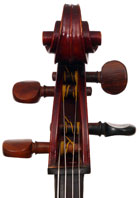Ref : 0777
A good French cello by the firm of
Jérôme Thibouville-Lamy
Labelled 'Michel-Ange GARINI'
Voges, circa 1905
The label, 'Michel-Ange Garini' was used in instruments distributed by the firm of Jérôme Thibouville-Lamy (usually referred to as JTL). In fact, no person by that name is listed in any of the important dictionaries of violin and bow makers - it was purely a generic label used to denote a certain series and quality of instrument.JTL instruments bearing this label were not made in the JTL studio in Mirecourt, but were in fact commissioned from another studio in Lorraine, over the period 1900 to 1920. All those I have seen are characterised by an attractive deep wine-red spirit-based varnish and bearing a very simple label, as shown in the photos.
These instruments were generally well-toned. JTL maintained high standards in their output, not only in choice of materials and workmanship, but very much so in tone. There craftsmen were generally superb and many of them, after completing their apprenticeship, went on to establish their own workshops and work successfully as master craftsmen. The firm reached it's zenith from around 1890 to about 1920 and instruments from that period can today be found throughout the world and are generally much respected by all dealers and musicians.
This cello has an immediate appeal to the eye, largely a consequence of its beautiful deep wine-red colour and is largely representative of the 'Michel-Ange Garini' instruments and workmanship. The wood for the back and ribs were cut on the slab (as apposed to cutting on the quart) resulting in a somewhat less figured look. The spirit- based varnish was cleverly applied and manipulated in such a way during the application as to create the impression of rich flames in the wood, whereas a close examination of the details of the varnish show that this is a clever superficiality. Yet, it works and the impression this creates is of the opulence of highly-flamed materials.
The one area that this instrument succeeds in very much is in the tone. It is a well-toned cello - well-balanced with an easy open sound and good projection, no doubt a consequence of the instrument's quite flat arching. A well-know local soloist and principal cellist, Boris Kerimov, tried this cello and found it suitable for very demanding playing. He played through the first movement of the Brahms double concerto on it and found the cello equal to all his demands with no constraints.
It is a good instrument by all standards and in good structural condition - no cracks or evident repairs. Any musician looking for good mature tone and easy response, need look no further. Kerimov feels it is eminently suitable for serious professional work.
 |
 |
 |
||
 |
Dimensions : Standard full-size. Stradivari model
Condition : In excellent condition. No cracks or evident repairs. Varnish is original. Some superficial marks and scratches are consistent with instruments of this age and pose no structural threat. The excessive use of hot glue around the lower bout seam between back and rib compromised the varnish superficially, probably when someone reglued an open seam at that area, but this is not obvious and is not a detractor. The cello still has its original endpin. One of the four pegs doesn't match the set, but does not affect the playabililty or function of the cello and could be seen to at a later stage.
Provenance : Owned by Johan Grobbelaar. Earlier provenance withheld
Price : Withheld
 |
 |
 |
 |
 |
 |
 |
 |
 |
 |
||||||
 |
 |
 |